

Launched at 4.0: mSchool. Where does learning happen?
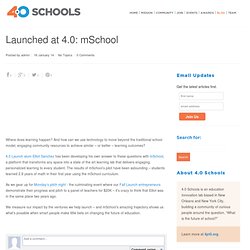
And how can we use technology to move beyond the traditional school model, engaging community resources to achieve similar – or better – learning outcomes? 4.0 Launch alum Elliot Sanchez has been developing his own answer to these questions with mSchool, a platform that transforms any space into a state of the art learning lab that delivers engaging, personalized learning to every student. The results of mSchool’s pilot have been astounding – students learned 2.9 years of math in their first year using the mSchool curriculum.
School Models. Models to Reach Every Student with Excellent Teaching, Within Budget This page contains links to school models that use job redesign and technology to extend the reach of excellent teachers to more students, for more pay, within budget.
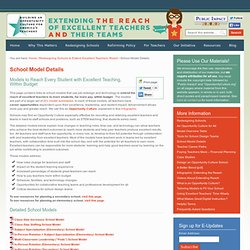
The models are part of a larger set of 20+ model summaries. In each of these models, all teachers have career opportunities dependent upon their excellence, leadership, and student impact. Advancement allows more pay and greater reach. We call this an Opportunity Culture, explained in this infographic. Schools may find an Opportunity Culture especially effective for recruiting and retaining excellent teachers and teams in hard-to-staff schools and positions, such as STEM teaching, that students sorely need. The detailed models below explain how changes in teaching roles, time use, and technology can allow teachers who achieve the best student outcomes to reach more students and help peer teachers produce excellent results, too.
These models address: School Design 101: Space. School Design 101: Space | Workshop Prompt One of our favorite design activities (which we stole from Education Elements) is to have groups of educators interview actual students and design learning experiences based on student needs.

Public Education Must Open Up and Innovate – Or Die. 8 Insane Schools, Playgrounds, And Libraries Of The Future. Zspace: The Future of 3D Learning - Getting Smart by Tom Vander Ark - STEM, virtual environments. I started my engineering career on a drafting board in the late seventies before CAD programs were widely used.
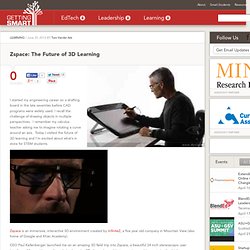
I recall the challenge of drawing objects in multiple perspectives. 10 Reasons Every District Should Open a Flex School. Flex is category of blended learning.
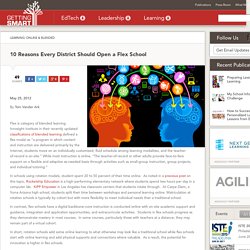
Innosight Institute in their recently updated classifications of blended learning defined a flex model as “a program in which content and instruction are delivered primarily by the Internet, students move on an individually customized, fluid schedule among learning modalities, and the teacher-of-record is on-site.” While most instruction is online, “The teacher-of-record or other adults provide face-to-face support on a flexible and adaptive as-needed basis through activities such as small-group instruction, group projects, and individual tutoring.”
In schools using rotation models, student spent 20 to 50 percent of their time online. As noted in a previous post on this topic, Rocketship Education is a high-performing elementary network where students spend two hours per day in a computer lab. KIPP Empower in Los Angeles has classroom centers that students rotate through. Flipping Blooms Taxonomy. Teacher Shelley Wright is on leave from her classroom, working with teachers in a half-dozen high schools to promote inquiry and connected learning.
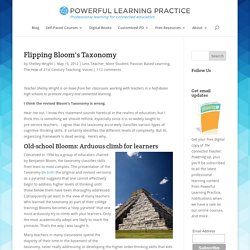
I think the revised Bloom’s Taxonomy is wrong. Who’s an Education Entrepreneur?: NewSchools Venture Fund. Jason Tomassini, a talented scribe who’s just joined the ink-stained ranks at Ed Week, alerted those of us who were asleep last weekend to a “spat” between Diane Ravitch, the education historian with the itchy Twitter finger, and Justin Hamilton, spokesman for the US Department of Ed.
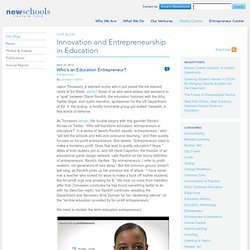
In the dustup, a mostly honorable group got sullied; herewith, a few words of defense. As Tomassini details, the trouble begins with this gauntlet Ravitch throws on Twitter: “Who will transform education: entrepreneurs or educators?” In a series of tweets Ravitch assails “entrepreneurs,” who “will sell the schools and kids and outsource teaching,” and then quickly focuses on for-profit entrepreneurs. She tweets, “Entrepreneurs need to make a monetary profit.
Does that lead to quality education? We need to reclaim the term education entrepreneurs. These are not the education entrepreneurs I know. To Flip Or Not Flip? To flip or not to flip? That is not the essential question. In assessing the optimal classroom dynamics, I would argue that we need to take a good look at what our classrooms look like right now, what activities our students gain the most from, what we wished we had more time for, and what things about our class we wish we could eliminate. UDL and The Flipped Classroom: The Full Picture. In response to all of the attention given to the flipped classroom, I proposed The Flipped Classroom: The Full Picture and The Flipped Classroom: The Full Picture for Higher Education in which the viewing of videos (often discussed on the primary focus of the flipped classroom) becomes a part of a larger cycle of learning based on an experiential cycle of learning. Universal Design for Learning has also been in the news lately as a new report Universal Design for Learning (UDL): Initiatives on the Move was released by the National Center on UDL, May, 2012.
This post describes the principles of Universal Design for Learning and how they naturally occur when a full cycle of learning, including ideas related to the flipped classroom, are used within the instructional process. Universal Design for Learning The UDL framework: Source: Blowing Up K-12? It seems sacrilegious, really, but I am advocating that we do away with the K-12 grade level structure in education.

Perhaps because it has been how we have organized our schools since we evolved from the one room schoolhouse back in the nineteenth century, the grade level structure is taken for granted. You notice that reform agendas do not include doing away with grade levels. We have vouchers, charters, extended day, extended school year, evaluating teachers and principals if we are not firing them, privatizing schools or closing them and reopening them under new management, but no talk of doing away with grade levels. If anything, there is renewed interest in having students repeat grades as a backlash against social promotion.
Warning Signs for Personalized Learning. A more nuanced, shared language to describe how online and blended learning differ from other forms of digital instruction is crucial to lasting educational change.

What if Learners Bartered for Instruction? Background.
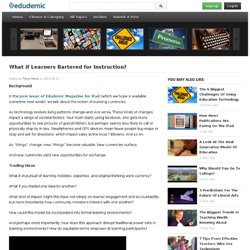
New education standards end rote learning, cursive. Like fashion, trends in public education come and go. Mind-reading robot teachers keep students focused - tech - 29 May 2012. An automated system that detects when online pupils are distracted or snoozing and then uses tricks to keep them alert WE ALL remember dozing off during a boring class at school. A robotic teacher that monitors students' attention levels and mimics the techniques human teachers use to hold their pupils' attention promises to end the snoozing, especially for students who have their lessons online.
Tests indicate the robot can boost how much students remember from their lessons. Intelligent tutoring systems that use virtual teachers to interact with students could play a crucial role in the expanding field of online education. Bill Gates spends $1.1 million fitting students with mood bracelets to see if their teachers are boring. By Daily Mail Reporter Published: 12:21 GMT, 12 June 2012 | Updated: 14:59 GMT, 12 June 2012 Microsoft supremo Bill Gates wants to fit school students with mood bracelets to measure how interested they are in their lessons.
The Bill and Melinda Gates foundation is spending $1.1 million (£700,000) testing galvanic skin response bracelets to see if they can measure whether students find their teachers engaging. The move is part of the billionaire’s mission to evaluate and improve the quality of teachers, which has already included controversial initiatives such as fitting classrooms with video cameras. One Per Cent: Kinect to watch your emotions and serve up ads. Rise of the Machines: Robots as Teaching Aides. Think back to when you were in grade school; were there ever any special tools or devices that teachers would sometimes use that got you excited about learning? Applying A Brain-Computer Interface For Children With ADHD. Digital Badges For Learning in the Classroom and Beyond. 6.20.12 | A pair of stories by Education Week reporter Katie Ash provides a big-picture overview of the pros and cons of digital badges and a close-up look at how badges are being used in a graduate course.
Gamification: Bring Gaming Mechanics Into Non-gaming Environments - Getting Smart by Adam Renfro - fixing failure, gamification, gaming, pace.